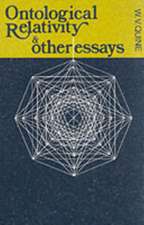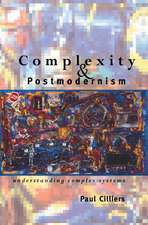Understanding Pictures: Oxford Philosophical Monographs
Autor Dominic Lopesen Limba Engleză Hardback – 28 mar 1996
| Toate formatele și edițiile | Preț | Express |
|---|---|---|
| Paperback (1) | 291.46 lei 31-37 zile | |
| OUP OXFORD – 27 mai 2004 | 291.46 lei 31-37 zile | |
| Hardback (1) | 388.11 lei 31-37 zile | |
| Clarendon Press – 28 mar 1996 | 388.11 lei 31-37 zile |
Din seria Oxford Philosophical Monographs
- 28%
 Preț: 416.30 lei
Preț: 416.30 lei - 24%
 Preț: 475.19 lei
Preț: 475.19 lei - 23%
 Preț: 459.51 lei
Preț: 459.51 lei - 18%
 Preț: 195.85 lei
Preț: 195.85 lei - 13%
 Preț: 169.46 lei
Preț: 169.46 lei - 27%
 Preț: 500.68 lei
Preț: 500.68 lei - 34%
 Preț: 817.82 lei
Preț: 817.82 lei - 34%
 Preț: 873.62 lei
Preț: 873.62 lei - 19%
 Preț: 329.95 lei
Preț: 329.95 lei - 34%
 Preț: 815.05 lei
Preț: 815.05 lei - 24%
 Preț: 348.65 lei
Preț: 348.65 lei - 24%
 Preț: 344.23 lei
Preț: 344.23 lei - 18%
 Preț: 297.31 lei
Preț: 297.31 lei - 26%
 Preț: 625.20 lei
Preț: 625.20 lei - 14%
 Preț: 332.04 lei
Preț: 332.04 lei - 31%
 Preț: 386.69 lei
Preț: 386.69 lei - 19%
 Preț: 350.86 lei
Preț: 350.86 lei - 18%
 Preț: 291.46 lei
Preț: 291.46 lei - 18%
 Preț: 323.52 lei
Preț: 323.52 lei - 28%
 Preț: 376.14 lei
Preț: 376.14 lei - 24%
 Preț: 336.48 lei
Preț: 336.48 lei - 19%
 Preț: 324.28 lei
Preț: 324.28 lei - 31%
 Preț: 327.42 lei
Preț: 327.42 lei - 34%
 Preț: 845.62 lei
Preț: 845.62 lei - 34%
 Preț: 712.76 lei
Preț: 712.76 lei - 34%
 Preț: 893.80 lei
Preț: 893.80 lei - 14%
 Preț: 352.44 lei
Preț: 352.44 lei - 34%
 Preț: 818.79 lei
Preț: 818.79 lei - 20%
 Preț: 265.80 lei
Preț: 265.80 lei - 22%
 Preț: 318.23 lei
Preț: 318.23 lei - 23%
 Preț: 329.64 lei
Preț: 329.64 lei - 25%
 Preț: 629.75 lei
Preț: 629.75 lei - 28%
 Preț: 417.57 lei
Preț: 417.57 lei - 11%
 Preț: 234.66 lei
Preț: 234.66 lei - 17%
 Preț: 516.03 lei
Preț: 516.03 lei - 12%
 Preț: 223.50 lei
Preț: 223.50 lei - 14%
 Preț: 473.71 lei
Preț: 473.71 lei - 27%
 Preț: 500.29 lei
Preț: 500.29 lei
Preț: 388.11 lei
Preț vechi: 564.86 lei
-31% Nou
Puncte Express: 582
Preț estimativ în valută:
74.29€ • 80.72$ • 62.44£
74.29€ • 80.72$ • 62.44£
Carte tipărită la comandă
Livrare economică 10-16 aprilie
Preluare comenzi: 021 569.72.76
Specificații
ISBN-13: 9780198240976
ISBN-10: 019824097X
Pagini: 248
Ilustrații: illustrations throughout
Dimensiuni: 145 x 224 x 21 mm
Greutate: 0.45 kg
Editura: Clarendon Press
Colecția Clarendon Press
Seria Oxford Philosophical Monographs
Locul publicării:Oxford, United Kingdom
ISBN-10: 019824097X
Pagini: 248
Ilustrații: illustrations throughout
Dimensiuni: 145 x 224 x 21 mm
Greutate: 0.45 kg
Editura: Clarendon Press
Colecția Clarendon Press
Seria Oxford Philosophical Monographs
Locul publicării:Oxford, United Kingdom
Recenzii
This is among the most subtle and carefully developed books on the topic of depiction to have hit the philosophical world since the great triumvirate of texts by Ernst Gombrich, Nelson Goodman, and Richard Wollheim defined the subject for analytical audiences. If this book finally leads to a series of puzzles about depiction that its terms of composition do not quite work out, the book has by that point produced such an excellent advance in the terms according to which the topic may be discussed as to have amply justified its aim of "theory-building."
The book is a worthwhile addition to the philosophical literature on pictorial representation.
a thorough treatment of pictorial representation that discriminatingly covers the recent literature and makes its own contribution to the subject. Drawing on material from recent work in the philosophy of language and of mind, and enriching the discussion with material in the psychology of perception and art history, the book is a more than welcome addition to the field.
Understanding Pictures has been a pleasure to read, full of riches and agreeably good humoured. Among other things it shows how pictures enlarge our recognitional capacities, it discusses various non-basic ways in which pictures refer to their sources, it offers extended treatment of fictional pictures and provides original reflection on what makes one picture a variation of another. I have learnt a good deal from it and confidently expect it to become a part of the standard literature of this absorbing topic.
Understanding Pictures is a rich, interesting and suggestive book ... Those seriously interested in depiction will certainly find much here to ponder.
... Lopes writes in a very engaging and accessible way, allowing of course for the inevitably abstruse elements that any serious intellectual work must have. ... those much less versed than he can expect to come away with a better understanding of what he shows to be an interesting subject. This is philosophical writing of a very high order, to my mind. Lopes is a master of simple, intriguing and compelling arguments./ Lopes is to be congratulated on producing a first-class work in philosophical aesthetics. Clarendon is also to be congratulated on an excellent production. Clear and simple typography is matched by the convenience of footnotes at the bottom of the page, and not a single misprint that I could spot./ Gordon Graham, University of Aberdeen, The Philosophical Quarterly, April 1999.
The book is a worthwhile addition to the philosophical literature on pictorial representation.
a thorough treatment of pictorial representation that discriminatingly covers the recent literature and makes its own contribution to the subject. Drawing on material from recent work in the philosophy of language and of mind, and enriching the discussion with material in the psychology of perception and art history, the book is a more than welcome addition to the field.
Understanding Pictures has been a pleasure to read, full of riches and agreeably good humoured. Among other things it shows how pictures enlarge our recognitional capacities, it discusses various non-basic ways in which pictures refer to their sources, it offers extended treatment of fictional pictures and provides original reflection on what makes one picture a variation of another. I have learnt a good deal from it and confidently expect it to become a part of the standard literature of this absorbing topic.
Understanding Pictures is a rich, interesting and suggestive book ... Those seriously interested in depiction will certainly find much here to ponder.
... Lopes writes in a very engaging and accessible way, allowing of course for the inevitably abstruse elements that any serious intellectual work must have. ... those much less versed than he can expect to come away with a better understanding of what he shows to be an interesting subject. This is philosophical writing of a very high order, to my mind. Lopes is a master of simple, intriguing and compelling arguments./ Lopes is to be congratulated on producing a first-class work in philosophical aesthetics. Clarendon is also to be congratulated on an excellent production. Clear and simple typography is matched by the convenience of footnotes at the bottom of the page, and not a single misprint that I could spot./ Gordon Graham, University of Aberdeen, The Philosophical Quarterly, April 1999.















